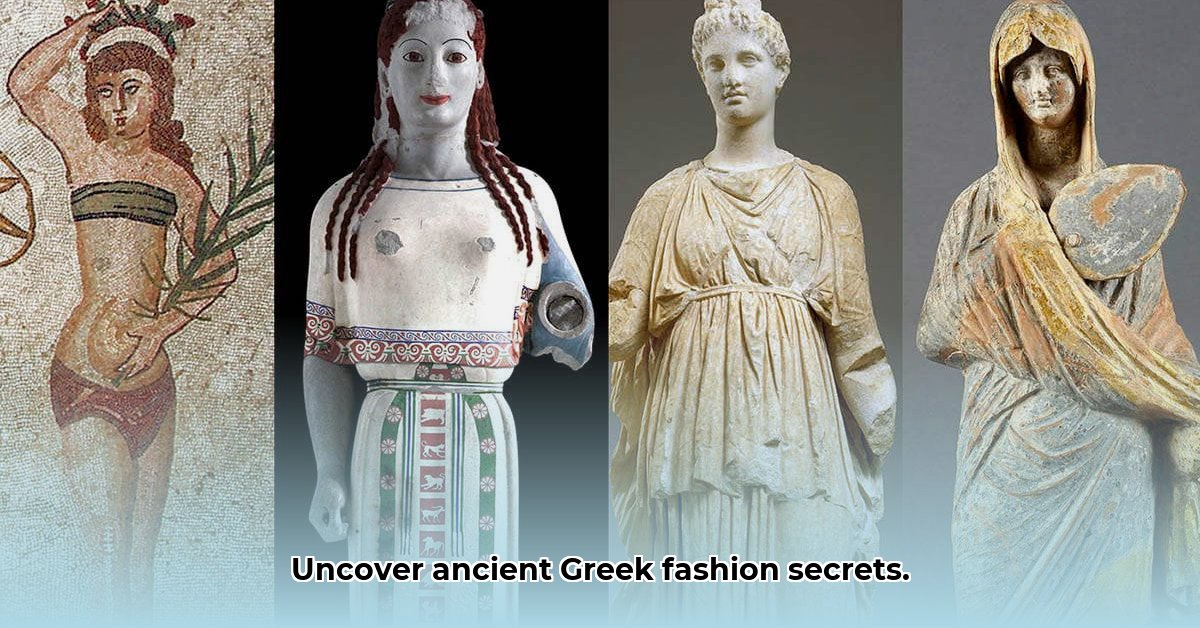
Imagine stepping back in time, strolling through the bustling agora of ancient Athens. The scent of olive oil and sea salt hangs in the air, but your eye is caught by something else: the vibrant tapestry of clothing. Ancient Greek fashion wasn't merely about covering the body; it was a powerful visual language, communicating wealth, status, gender, and even regional identity. This journey explores the evolution of these styles, from the earliest Minoan garments to the enduring legacy that continues to inspire designers today. For a deeper dive into Greek clothing, check out this excellent resource.
Minoan and Mycenaean Beginnings: The Dawn of Style
Long before the rise of the classical polis (city-state), the Minoans and Mycenaeans laid the foundation for Greek fashion. Evidence from frescoes and pottery fragments reveals a preference for richly colored fabrics, intricate patterns, and perhaps even the occasional glittering adornment. Women likely wore flowing skirts, often complemented by elaborate headwear. The craftsmanship and lavish materials suggest that clothing served as a potent symbol of social status, even at this early stage. These early styles highlight that fashion, even in its infancy, was a powerful tool of self-expression.
The Archaic and Classical Eras: A Simpler Elegance
By the Archaic and Classical periods (roughly 8th to 4th centuries BC), a shift occurred. The earlier, more elaborate styles gave way to simpler, draped garments. This transition likely resulted from advancements in weaving techniques and broader societal changes that favored a more streamlined aesthetic. This era saw the emergence of iconic garments: the chiton (a simple tunic), the himation (a versatile cloak), the peplos (a long dress worn by women), and the chlamys (a shorter cloak for men). These garments, usually made of linen or wool, offered surprising versatility despite their seemingly simple designs. A chiton, for instance, could be worn alone or as a base layer beneath a cloak, adapting to the weather and the occasion. Were these garments truly simple, or did their seemingly effortless elegance belie an underlying mastery of draping and design?
Reading Between the Threads: Social Signals and Symbolic Meanings
Ancient Greek clothing was a powerful communication tool. The fabric—was it luxurious wool or humble linen?—the color—was it the costly purple dye from Murex snails or a more common earth tone?—and even the way a garment was draped all signaled the wearer's place in society. A wealthy aristocrat in flowing purple robes would have stood in stark contrast to a farmer in basic linen. Gender and marital status were also conveyed through clothing. Married women, for instance, might have worn their hair differently or chosen specific styles that distinguished them from their unmarried counterparts. Even regional identity may have been subtly communicated through variations in style and embellishment. Professor Penelope Davies, an expert in ancient textiles at the University of Oxford, notes: “Clothing choices were far from arbitrary; they were integral to how individuals presented themselves and navigated their social world.”
Regional Styles: A Diverse Fashion Landscape
Ancient Greece wasn't a monolithic culture. The diverse city-states, each with its unique character, naturally influenced their fashions. Spartan clothing favored practicality and simplicity, reflecting the city’s emphasis on military strength and austere values. Athenian fashion was, by contrast, often more elaborate, reflecting the city's wealthier and more sophisticated culture. These differences extend beyond the general style to include specific details and adornments. The variations between city-states highlight how closely clothing mirrored the cultural values and priorities of a community.
A Rainbow of Status: Color and Decoration
Color was far from arbitrary in ancient Greece. While white was common, the use of vibrant dyes, especially the deep purple derived from Murex snails, conveyed high social standing. The sheer cost of these dyes made them incredibly exclusive. Embroidery, precious jewelry, and other embellishments further enhanced garments, adding layers of personal expression and underscoring social hierarchy. How did the use of color and decoration contribute to the visual narrative of a person's standing in society? It's a question that continues to fascinate researchers today.
The Enduring Legacy: Echoes Through Time
The influence of Ancient Greek fashion resonates even today. The elegant simplicity of draped garments and the emphasis on flowing lines continue to inspire designers. From the Roman toga to modern haute couture, the enduring appeal of Ancient Greek aesthetics is undeniable. The impact on contemporary fashion proves that even after millennia, the visual language of ancient Greece remains both powerful and relevant. What elements of ancient Greek fashion still inspire contemporary designers, and how have these elements been adapted to modern styles? This question warrants further exploration, and is a testament to the timeless appeal of ancient Greek aesthetics.
Key Garments of Ancient Greece: A Quick Reference
This table offers a concise overview of some key garments, though it is essential to remember that the meaning and significance of clothing in ancient Greece were far more nuanced and complex than can be captured in a simple table.
| Garment | Description | Typical Wearer | Social Significance |
|---|---|---|---|
| Chiton | Simple tunic, often belted | Men and Women | Everyday garment; variations indicated status. |
| Himation | Large, rectangular cloak; versatile | Men and Women | Signified wealth and social standing. |
| Peplos | Long, draped garment, often elaborately decorated | Women | Worn by women; could be heavily adorned. |
| Chlamys | Short cloak; favored by active individuals | Men | Associated with warriors and those who needed mobility. |
This article serves as a starting point for understanding the complex interplay between fashion, social structure, and cultural identity in ancient Greece. Further research into regional variations, specific dyeing techniques, and the social significance of particular embellishments will deepen our understanding of this fascinating subject.